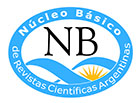After the #DemocraticConsolidation: Social networks, polarization and fake news
Keywords:
Digital Social Networks, Micro-messaging, Influencers, Disinformation, Governmental InstitutionsAbstract
En las últimas cuatro décadas, las redes sociales digitales experimentaron una transformación sin precedentes, pasando de la inexistencia a desempeñar un papel fundamental en el ámbito político y social. La polarización era ideológica y no afectiva, y los procesos políticos estaban dominados por gobiernos, partidos, sindicatos y asociaciones empresarias. Hoy, la dinámica ha cambiado drásticamente. La deliberación en las democracias ya no se basa en largos intercambios filosóficos, sino en la circulación descentralizada de millones de micro-mensajes en espacios dominados por una élite de influencers. Este nuevo entorno también facilita la propagación de noticias falsas y teorías de conspiración, minando la confianza en las instituciones gubernamentales, en los medios de comunicación tradicionales y en la información educativa y científica. La sociedad se enfrenta, entonces, desafíos fundamentales relacionados con la gestión de la desinformación, la regulación de las redes sociales y la promoción de un diálogo político más constructivo en un contexto en el cual las mismas continuaran siendo una parte integral de la vida cotidiana de las y los ciudadanos.
Downloads
References
Aruguete, N. et al. (2023). Truth Be Told: How ‘True’ and ‘False’ Labels Influence User Engagement with Fact-Checks. New Media & Society Early Von, 68(3), 480–502.
Aruguete, N., Calvo, E. and Ventura, T. (2023a). Network Activated Frames: Content Sharing and Perceived Polarization in Social Media. Journal of Communication Early view: 14–24. https://doi.org/10.1093/joc/jqac035.
Aruguete, N., Calvo, E. and Ventura, T. (2023b). News by Popular Demand: Ideological Congruence, Issue Salience, and Media Reputation in News Sharing. The International Journal of Press/Politics, 28(3), 558–79.
Bakshy, E., Messing, S. and Adamic, L. (2015). Exposure to Ideologically Diverse News and Opinion on Facebook. Science, 348(6239), 1130–1132.
Barberá, P. et al. (2015). Tweeting from Left to Right: Is Online Political Communication More than an Echo Chamber? Psychological Science, 26(10), 1531–42.
Barnidge, M. (2017). Exposure to Political Disagreement in Social Media versus Face-to-Face and Anonymous Online Settings. Political Communication, 34(2), 302–21.
Calvo, E. (2015). Anatomía Política de Twitter En Argentina. Tuiteando #Nisman. Buenos Aires: Capital Intelectual.
Calvo, E. and Ventura, T. (2021). Will I Get COVID-19? Partisanship, Social Media Frames, and Perceptions of Health Risk in Brazil. Latin American Politics and Society, 63(1), 1–26.
Christensen, K. R. (2020). The Neurology of Negation: Fmri, Erp, and Aphasia. In The Oxford Handbook of Negation (pp. 725–39). Oxford: Oxford University Press.
Clerici, P., Cruz, F. and Goyburu, L. (2017). Dos Territorios. Las Elecciones Argentinas 2015 En Twitter. Más Poder Local, 30(14–16).
Conover, M. D. et al. (2011). Political Polarization on Twitter. In Fifth International AAAI Conference on Weblogs and Social Media. Recuperado de https://aaai.org/conference/icwsm/icwsm11/
Fletcher, R., and Nielsen, R. K. (2018). Are People Incidentally Exposed to News on Social Media? A Comparative Analysis. New Media & Society, 20(7), 2450–68.
Gentzkow, M. and Shapiro, J.M. (2011). Ideological Segregation Online and Offline. The Quarterly Journal of Economics, 126(4), 1799–1839.
Guess, A. M., Barberá, P. , Munzert, S. and Yang, J. (2021). The Consequences of Online Partisan Media. Proceedings of the National Academy of Sciences, 118(14).
Lyengar, S., Sood, G. and Lelkes, Y. (2012). Affect, Not Ideology: A Social Identity Perspective on Polarization. Public Opinion Quarterly, 76(3), 405–431.
Kahneman, D. (2011). Thinking, Fast and Slow. MacMillan.
Kaiser, J., Vaccari, C. and Chadwick, A. (2022). Partisan Blocking: Biased Responses to Shared Misinformation Contribute to Network Polarization on Social Media. Journal of Communication, 72(2), 214–240.
Mason, L. (2013). The Rise of Uncivil Agreement: Issue Versus Behavioral Polarization in the American Elec-torate. American Behavioral Scientist, 57(1), 140–59.
Mason, L. (2018). Uncivil Agreement: How Politics Became Our Identity. University of Chicago Press.
Merrill, S., Grofman, B. and Adams, J. (2001). Assimilation and Contrast Effects in Voter Projections of Party Locations: Evidence from Norway, France, and the USA. European Journal of Political Research, 40, 199–223.
Pariser, E. (2011). The Filter Bubble: What the Internet Is Hiding from You. London: Peguin.
Törnberg, P. (2018). Echo Chambers and Viral Misinformation: Modeling Fake News as Complex Contagion. PLoS ONE, 13(9). https://doi.org/%0A10.1371/journal.pone.0203958.
Waisbord, S. (2022). Más Que Infodemia: Pandemia, Posverdad y El Peligro Del Irracionalismo. InMediaciones de la Comunicación, 17(1), 31–53.
Walter, N., Cohen, J., Holbert, L. and Morag, Y. (2020). Fact-Checking: A Meta-Analysis of What Works and for Whom. Political Communication, 37(3), 350–75.
Wardle, C. and Derakhshan, H. (2017). Information Disorder: Toward an Interdisciplinary Framework for Research and Policy Making. Council of Europe, 27.DOSSIER. XXVII Congreso de la International Political Science Association.
Downloads
Published
How to Cite
Issue
Section
License

This work is licensed under a Creative Commons Attribution-NonCommercial-ShareAlike 4.0 International License.
Manuscript acceptance by the Journal implies the simultaneous non-submission to any other journal or publishing house, and the non-exclusive transmission of the author´s patrimonial rights in favor of the editor, who allows the post-print version use, under the Licencia Creative Commnos Atribución-NoComercial-Compartir Obras Derivadas Igual 4.0 Internacional (CC-BY-NC.SA 4.0) (http://creativecommons.org/licences/by-nc-sa/4.0/deed.es). Articles can be shared, copied, distributed, modified, altered, transformed into a derivative work, executed and publicly communicated, provided a) the authors and the original publication (Journal, Publisher and URL) are mentioned, b) they are not used for commercial purposes, c) the same terms of the license are maintained.
It is hereby stated that the mentioned manuscript has not been published and that it is not being printed in any other national or foreign journal.
The authors hereby accept the necessary modifications, suggested by the reviewers, in order to adapt the manuscript to the style and publication rules of this Journal.









